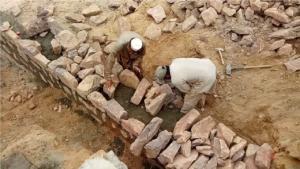Stone Masonry Its 7 Different requirements in its Construction
A stone masonry structure is formed by combining a masonry unit like the stone with mortar. Stonemasonry is one of the oldest construction materials. Ancient masonry structure includes the pyramids of Egypt and the Great Wall of China and Greek and Roman ruins.
Stone is a natural product building material and it is available in the form of rocks and then cut into different sizes and then use for construction purposes. Stonemasonry walls are used all over the world and its strength is greater than bricks.
- Stones used for the masonry purpose should be in the best quality and obtained in the locality.
- It should be hard sound and free from veins flows and defects.
- It shall be of suitable sizes and in one piece where ordered any of the sandstone, granite, trap, quartzite and limestone’s, etc.

Selection of Stones for Masonry
Stones that we mainly use in the building construction must be cheap, hard, durable and naturally good looking. Every stone has its own properties and has different types. There must be some criteria for the selection of stones for construction. The criteria for the selection of stones for stone masonry are based on the following parameters.
1: Appearance
The appearance of stones plays an important role in the beauty of the structure. The aesthetic aspect of the stone is the color of the stone. The appearance of stone must also be of uniform.
2: Chemical composition:
The chemical properties and chemical composition of the stones must be tested and verified before use in the building construction because different elements and compounds in stones have different properties.
For instance, the magnesium is limestone causes it to be stronger and is called dolomite. Feldspar, in large quantities in stone is a source of weakness because co2 dissolves potassium, sodium and even calcium in the feldspar leaving pure white clay behind. The presence of Mica even less than 2 to 3% makes stone unsuitable for building purposes.
- Stones with silicates as cementing materials are resistant to weathering.
3: Resistance to Heat:
The stone must have a very low amount of expansion due to the large increase in temperature. Siliceous material is good at areas where resistance to fire is present.
4: Strength and Hardness:
Stonewall subjected to the vibration of machinery and moving loads should necessarily possess toughness. The specific gravity of good stone shall be 2.7. A crystalline stone is superior to a non-crystalline texture. Stones used for road metal, paving blocks, floor slabs, and railway ballast have to withstand mainly abrasion or wear and tear.
5: Bio-deterioration:
Certain trees and creepers thrust their roots in the joints of stones and have both mechanical and chemical adverse effects. Special microbes can grow on the surface and in minute fissures, their by-products cause discoloration and flaking.
Stone Masonry in Superstructure
The stone used in superstructure should be hard, durable and of the approved quarry as specified.
- Stone shall be laid as per specification bond with (1:3 or 1:4 cement, sand, and mortar).
Each stone should be laid chisel bond, and each course shall be truly horizontal the wall should be truly in plumb line Not more than the 60 cm height of masonry should be considered at a time. First curing is don on all the stones before use. The measurement is processing in cubic meter or cubic feet; all the deduction shall be the same as you considered in brickwork.
Stone Masonry in Foundation
The stones should be hard, tough and durable of approved quarry shall be used over a bed of PCC 1:4:8 cement concrete. Stones should be well dressed and quarried with the straight edges should be preferable chisel dressed stone shall be used in 1:3 or 1:4 cement, sand.
The stones size should be as per approved drawing or 8-inch height, 12 inches in length and 10 inches wide may be used. The stones shall be laid as per specification or shall be laid alternate header and stretchers with break joints. The measurement of the stonework is processing in cubic feet.
Construction Requirement for Stone Masonry
1: Cement:
The cement should be of Ordinary Portland normal setting of any brand.
2: Sand:
Sand should be sharp, hard, cubical and dense the whole of which shall be pass through 5mm sieve size and 2 to 10% through sieve #100.
- Sand should be free from organic impurities and clay lumps.
3: Face:
Roughly hammer-dressed, no face stone to be narrower or shorter than its heights.
4: Beds and joints:
Not to exceed 19 mm thick. Side joint in each course shall break joint at least 75 mm with those of courses above and below and not from an angle with bed joints less than 60 degrees.
5: Through bonding stone and lap bending stone:
Three per 1sqm of the face and staggered, no stone to tall a point. In walls over 600mm thick LBS may also use in lieu lap bending stone.
6: Quoins:
Face beds to be squared back 100 mm and joint 63 mm.
7: Hearting:
Stone is not less than 6 inches in any direction, bedded with mortar, chips, and spalls, being wedged in to avoid thick beds and joints of mortar.
Uses of Stones in Masonry Structures
There are following uses of stones are used for
- Making retaining walls, breast walls, good looking steps.
- Constructing foundation and in sub or superstructure.
- The construction for flooring, walls, columns and are in arches.
- Marble, granite, laterite, slate, and quartzite are widely used for the facing works.
- The construction of dams. Piers and abutments of the bridges.
- It is most suitable in the hilly area construction.
- Use in slabs as damp proof courses.
- The paving roads and for footpaths.
Video:
